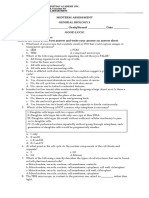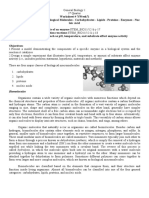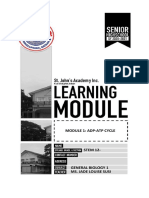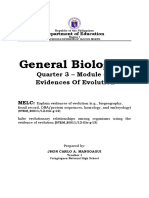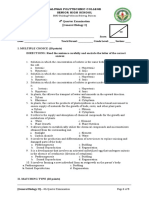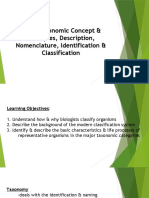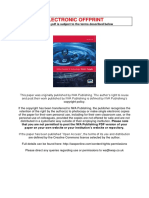Professional Documents
Culture Documents
2nd Quarter FINAL EXAM General Biology 1
2nd Quarter FINAL EXAM General Biology 1
Uploaded by
Cherrina AguilaOriginal Description:
Original Title
Copyright
Available Formats
Share this document
Did you find this document useful?
Is this content inappropriate?
Report this DocumentCopyright:
Available Formats
2nd Quarter FINAL EXAM General Biology 1
2nd Quarter FINAL EXAM General Biology 1
Uploaded by
Cherrina AguilaCopyright:
Available Formats
Sabang National High School
Polillo, Quezon
SECOND QUARTER
FINAL EXAMINATION IN GENERAL BIOLOGY 1
Name: _________________________________________________Section:_______________________ Date: ____________
I. MULTIPLE CHOICE: Encircle the letter of the correct answer. Erasures are not allowed.
1. At midday, what is happening in the leaf of a plant?
a) Respiration b) Photosynthesis c) Mainly photosynthesis and some respiration d) None
2. Which of the following need oxygen to survive?
a) Plants b) Animals c) Plants and animals d) None
3 – 10. Encircle A if it pertains to Light Reaction and B if it pertains to Dark Reaction
3. Strikes chlorophyll bodies and electrons are excited. A B
4. Reduce carbon dioxide A B
5. Glucose is formed as a by-product A B
6. ATP and NADPH are the by-products A B
7. Water molecules split that results to the release of oxygen A B
8. Cyclic and noncyclic A B
9. Completes the process of photosynthesis A B
10. Photon is required A B
11. The process that converts sugar into energy
a. Cellular respiration b. Digestion c. Metabolism d. Photosynthesis
12. The correct equation for cellular respiration is?
a. 6O2 + C6H12O6 → 6CO2 + 6H2O + Energy
b. 6O2 + C6H12O6 + Energy → 6CO2 + 6H2O
c. 6CO2 + H2O → CO2 + C6H12O + Energy
d. 6CO2 + H2O + Energy → CO2 + C6H12O
13. The reactants of cellular respiration are?
a. carbon dioxide and water b. glucose and oxygen c. oxygen and lactic acid d. water and glucose
14. Which process does NOT release energy from glucose?
a. cellular respiration b. fermentation c. glycolysis d. photosynthesis
15. The correct sequence of events in cellular respiration?
a. glycolysis → fermentation →Krebs cycle
b. glycolysis → Krebs cycle → oxidative phosphorylation
c. Krebs cycle → electron transport → glycolysis
d. Krebs cycle → glycolysis →oxidative phosphorylation
16. The two main types of fermentation are called
a. aerobic and anaerobic b. alcoholic and anaerobic
c. alcoholic and lactic acid d. lactic acid and anaerobic
17. Cellular respiration occurs in which cell type?
a. animal cells only b. plant cells only c. both plant and animal cells d. all but plant cells
18. What function does ATP carry out in living things?
a. Aids in protein folding and coiling b. Used to capture and transfer energy
c. Identifies DNA start sequences for transcription d. Helps maintain the fluidity of cell membranes
19. Which statement describes how photosynthesis and cellular respiration are interrelated?
a. Oxygen is produced during cellular respiration and stored during photosynthesis.
b. Carbon dioxide released by cellular respiration is used in photosynthesis.
c. Photosynthesis releases the energy that is stored during the process of cellular respiration.
d. Glucose is used during cellular respiration to produce food that is broken down during photosynthesis
20. Cellular respiration uses one molecule of glucose to produce
a. 2 ATP molecules b. 34 ATP molecule c. 36 ATP molecules. d. 38 ATP molecules
II. Identification:
A. Read each statement and identify. Look for the write answer in this box.
Respiration/Cellular Respiration Glucose and Oxygen Photosynthesis Alcohol
Mitochondria Carbon dioxide Lactic acid ATP
Aerobic Fermentation
______________1. Conversion of food molecules to release stored energy.
______________2. Reactants of respiration
______________3. Reverse process of respiration
______________4. Site of respiration
______________5. Gas that is produce during respiration
______________6. Currency of energy used by cells
______________7. Respiration that takes in the presence of oxygen
______________8. Another term for anaerobic respiration
______________9. Type of fermentation that produces lactic acid
______________10. A product of anaerobic respiration in some microorganism like yeast.
B. Check your overall understanding of cellular respiration by matching each of the phrases below with one of the three stages of the process. Use
G for glycolysis, KC for Krebs cycle, and OP for oxidative phosphorylation.
________ 1. Generates most of the ATP formed by cellular respiration.
________ 2. Begins the oxidation of glucose.
________ 3. Occurs outside the mitochondrion.
________ 4. Produces 4 ATP s per glucose, but 2ATPs per glucose are used to get it started.
________ 5. Oxidizes NADH and FADH2, producing NAD+ and FAD.
________ 6. Carried out by enzymes in the matrix (fluid) of the mitochondrion.
________ 7. Generates most of the CO2 produced by cellular respiration.
________ 8.FADH2 and NADH deliver high--‐energy electrons to this stage.
________ 9. ATP synthase makes ATP.
________ 10. Reduces NAD+ and FAD, producing NADH and FADH2.
You might also like
- General Biology II A - Answer KeyDocument13 pagesGeneral Biology II A - Answer Keyjames100% (2)
- Moments of Greatness - Entering The Fundamental State of LeadershipDocument31 pagesMoments of Greatness - Entering The Fundamental State of LeadershipJahanzaib Mehmood (JMC)100% (2)
- GB2 Q3 Summative-Test-2Document9 pagesGB2 Q3 Summative-Test-2Margarette Buque100% (1)
- DSR Elec 2022 PDFDocument155 pagesDSR Elec 2022 PDFShivam50% (2)
- General Biology 1-1st Quarter ExamDocument6 pagesGeneral Biology 1-1st Quarter ExamQueng Eledia83% (12)
- General Biology 1: Quarter 2 - Module 1 Energy TransformationDocument45 pagesGeneral Biology 1: Quarter 2 - Module 1 Energy Transformationrhaine89% (18)
- Gen Bio Mid Term ExamDocument6 pagesGen Bio Mid Term ExamWelbert AmarNo ratings yet
- Summative Test Week 1 - 4 Practical Research 2Document2 pagesSummative Test Week 1 - 4 Practical Research 2Cherrina AguilaNo ratings yet
- General Biology 1 Q1 Week 7 BiomoleculesDocument5 pagesGeneral Biology 1 Q1 Week 7 BiomoleculesJohn Brylle UrsuaNo ratings yet
- General Biology 2: Quarter 1 - Module 6: SystematicsDocument32 pagesGeneral Biology 2: Quarter 1 - Module 6: SystematicsJanzyron Dacumos David100% (2)
- General Biology 2: Quarter 3 - Module 3 Evolution & HeredityDocument6 pagesGeneral Biology 2: Quarter 3 - Module 3 Evolution & HeredityCamille Castrence CaranayNo ratings yet
- General Biology 2 Quarter 4Document48 pagesGeneral Biology 2 Quarter 4Kishly Concepcion78% (9)
- SUMMATIVE TEST-SCIENCE 9 (Photosynthesis & Cellular Respiration)Document3 pagesSUMMATIVE TEST-SCIENCE 9 (Photosynthesis & Cellular Respiration)lavenia acdal100% (2)
- General Instruction: Please Avoid Erasures Any Form of Erasures Are Not CountedDocument4 pagesGeneral Instruction: Please Avoid Erasures Any Form of Erasures Are Not CountedCherrina AguilaNo ratings yet
- Field Guide To SuldanDocument250 pagesField Guide To Suldanadesso napoliNo ratings yet
- Summative Test #2 Gen BioDocument2 pagesSummative Test #2 Gen BioKennedy Fieldad Vagay100% (1)
- Bio 1 Finals 11 STEMDocument3 pagesBio 1 Finals 11 STEMRosana De AsisNo ratings yet
- Summative Test #1 Gen BioDocument3 pagesSummative Test #1 Gen BioKennedy Fieldad Vagay100% (2)
- General Biology 1 Final Exam 2nd QuarterDocument9 pagesGeneral Biology 1 Final Exam 2nd Quarterjoei Arquero100% (1)
- 3RD QUARTER EXAM I GENERAL BIOLOGY 2 - FEBRUARY 28 2023 - 10 - 00AM 12 - 00PM - General Biology 2 S2 AY22 23 ST12I PDFDocument16 pages3RD QUARTER EXAM I GENERAL BIOLOGY 2 - FEBRUARY 28 2023 - 10 - 00AM 12 - 00PM - General Biology 2 S2 AY22 23 ST12I PDFB9 GENE MARVIN S. BORBON100% (1)
- Gen Bio 1 - Quarter 2 Summative Test 1Document2 pagesGen Bio 1 - Quarter 2 Summative Test 1Syrine Myles Sullivan100% (2)
- General Biology 2: Nutrition of Plants and AnimalsDocument19 pagesGeneral Biology 2: Nutrition of Plants and AnimalsBea Bayona Jolo50% (2)
- General Biology 1: Quarter 2 - Week 1 - Module 1Document11 pagesGeneral Biology 1: Quarter 2 - Week 1 - Module 1Regine Ann ViloriaNo ratings yet
- Gen Bio2 Summative TestDocument2 pagesGen Bio2 Summative Testjulzhaide0% (1)
- 1st Summative Test Biology 1Document3 pages1st Summative Test Biology 1julzhaideNo ratings yet
- Recombinant DNA: Module in General Biology 2Document27 pagesRecombinant DNA: Module in General Biology 2Shastine ClaorNo ratings yet
- 2ND QTR MODULE 1-StudentsDocument12 pages2ND QTR MODULE 1-StudentsDimple MontemayorNo ratings yet
- Diagnostic Test in General Biology IDocument6 pagesDiagnostic Test in General Biology ISamantha RullaNo ratings yet
- Summative Test #3 Gen BioDocument3 pagesSummative Test #3 Gen BioKennedy Fieldad VagayNo ratings yet
- General Biology 1 Module 8 Q1Document21 pagesGeneral Biology 1 Module 8 Q1Pril Gueta100% (4)
- Bio 1 Module 4Document8 pagesBio 1 Module 4yhajj jamesNo ratings yet
- General Biology 2: Quarter 3 - Module 4: Evidences of EvolutionDocument39 pagesGeneral Biology 2: Quarter 3 - Module 4: Evidences of EvolutionCzarina Nicole Damo67% (3)
- General Biology 1: Quarter 1 - Module 3: Title: Prokaryotic vs. Eukaryotic CellDocument16 pagesGeneral Biology 1: Quarter 1 - Module 3: Title: Prokaryotic vs. Eukaryotic CellLyka Mae Benito100% (1)
- GB2 Q3 Summative-Test-1Document7 pagesGB2 Q3 Summative-Test-1Margarette Buque100% (2)
- General Biology 1 Long TestDocument3 pagesGeneral Biology 1 Long TestQueng Eledia100% (1)
- General Biology 1: Learning Activity Sheet: Cell ModificationsDocument15 pagesGeneral Biology 1: Learning Activity Sheet: Cell ModificationsKennedy Fieldad Vagay100% (1)
- Gen Bio Periodic TestDocument7 pagesGen Bio Periodic TestRestyness Farochilin Tambo-ong33% (3)
- Gen Bio IIDocument3 pagesGen Bio IIBelle MemoraBilya100% (1)
- Biology2 Summative-Test 2ndsemDocument3 pagesBiology2 Summative-Test 2ndsemRaymond Traqueña100% (2)
- GENBIO2 MOD4 Mechanisms of Change of Population.Document22 pagesGENBIO2 MOD4 Mechanisms of Change of Population.Kris LaglivaNo ratings yet
- General Biology 1: Quarter I - Module 7 Biological Molecules-EnzymesDocument27 pagesGeneral Biology 1: Quarter I - Module 7 Biological Molecules-EnzymesJohn Joseph Jalandoni67% (3)
- Basic Taxonomic Concept & Principles, Description, Nomenclature, Identification & ClassificationDocument28 pagesBasic Taxonomic Concept & Principles, Description, Nomenclature, Identification & ClassificationKaela Sophia AndalisNo ratings yet
- Biology 1 ExaminationDocument3 pagesBiology 1 ExaminationMa Es Tro100% (3)
- 3rd Summative Test in General Chemistry 2Document1 page3rd Summative Test in General Chemistry 2christian baltao100% (1)
- 1st Quarterly Exam in General BioDocument6 pages1st Quarterly Exam in General BioVinlax ArguillesNo ratings yet
- Learning Activity Sheet General Biology 2 (Q4 - WK 5-6) Feedback MechanismDocument11 pagesLearning Activity Sheet General Biology 2 (Q4 - WK 5-6) Feedback MechanismJeffrey YumangNo ratings yet
- General Biology 1: Quarter 1 - Module 1Document20 pagesGeneral Biology 1: Quarter 1 - Module 1Pril Gueta100% (2)
- General Biology II Final ExamDocument5 pagesGeneral Biology II Final ExamMayar Hasan100% (1)
- General Biology 2: Quarter 1 - Module 3: Mechanisms of EvolutionDocument28 pagesGeneral Biology 2: Quarter 1 - Module 3: Mechanisms of EvolutionArthe Agustin100% (3)
- General Biology 2: Quarter 3-Module 2: History of Life On EarthDocument21 pagesGeneral Biology 2: Quarter 3-Module 2: History of Life On EarthJohn Michael RomarezNo ratings yet
- MIDTERM EXAMINATION IN GEN BIO 1 Cell TheoryDocument4 pagesMIDTERM EXAMINATION IN GEN BIO 1 Cell TheoryIAN MAR VALENZUELA100% (1)
- Chlorophyll and Other PigmentsDocument19 pagesChlorophyll and Other PigmentsMeghan Old67% (3)
- GNBIO 2 3rd Quarter Examination ReviewerDocument10 pagesGNBIO 2 3rd Quarter Examination ReviewerAngelica JanoyNo ratings yet
- General Biology 1 Quarter 2 As Revised by Leo JR Icutan and Isabelo RamosDocument25 pagesGeneral Biology 1 Quarter 2 As Revised by Leo JR Icutan and Isabelo RamosSeverus S Potter100% (1)
- 1st Summative Exam in General Biology 2Document1 page1st Summative Exam in General Biology 2Eula Pacifico100% (1)
- Gen Bio 2 Mod3doneDocument45 pagesGen Bio 2 Mod3doneNikki AlquinoNo ratings yet
- General Biology 2: Quarter 3 - Module 4 Evolution & HeredityDocument7 pagesGeneral Biology 2: Quarter 3 - Module 4 Evolution & HeredityCamille Castrence CaranayNo ratings yet
- Instruction: Choose The Letter That Corresponds To The Word or Phrase That BestDocument19 pagesInstruction: Choose The Letter That Corresponds To The Word or Phrase That BesterraNo ratings yet
- General Biology1 - Q1 - Module 15 - Oxidation-and-Reduction-ReactionsDocument18 pagesGeneral Biology1 - Q1 - Module 15 - Oxidation-and-Reduction-ReactionsSyrine Myles Sullivan0% (2)
- General Biology 1 Summative Assessment Week 1-4Document2 pagesGeneral Biology 1 Summative Assessment Week 1-4Cherrina Aguila100% (1)
- General Biology - Q2 - Week 2Document23 pagesGeneral Biology - Q2 - Week 2Renard JaenNo ratings yet
- General Biology 2 Diagnostic TestDocument11 pagesGeneral Biology 2 Diagnostic TestDearest NotesNo ratings yet
- GB2 Q3 Summative-Test-3Document9 pagesGB2 Q3 Summative-Test-3Margarette BuqueNo ratings yet
- General Biology 1: Quarter 1 - Module1: Postulates of The Cell TheoryDocument12 pagesGeneral Biology 1: Quarter 1 - Module1: Postulates of The Cell TheoryAyessa Karyl Ganir100% (1)
- Q2 SHS - PT - Gen Biology 1 - 2022 - 23Document6 pagesQ2 SHS - PT - Gen Biology 1 - 2022 - 23Diane GuilaranNo ratings yet
- CHEM 2 Pre Finals Examination 2022-2023Document1 pageCHEM 2 Pre Finals Examination 2022-2023Cherrina AguilaNo ratings yet
- CHEM 2 Finals Examination 2022-2023Document2 pagesCHEM 2 Finals Examination 2022-2023Cherrina AguilaNo ratings yet
- Summative Test Week 1 - 4 P.EDocument2 pagesSummative Test Week 1 - 4 P.ECherrina AguilaNo ratings yet
- 2nd Quarter FINAL EXAM Practical Research 2Document3 pages2nd Quarter FINAL EXAM Practical Research 2Cherrina AguilaNo ratings yet
- 2nd Quarter FINAL EXAM Introduction To The Human PhilosophyDocument2 pages2nd Quarter FINAL EXAM Introduction To The Human PhilosophyCherrina AguilaNo ratings yet
- Mrtena Manuscript For DefenseDocument104 pagesMrtena Manuscript For DefenseCherrina AguilaNo ratings yet
- 2nd Quarter FINAL EXAM Earth and Life ScienceDocument3 pages2nd Quarter FINAL EXAM Earth and Life ScienceCherrina Aguila100% (2)
- Intro To Philosophy Summative Assessment Week 1 - 4Document1 pageIntro To Philosophy Summative Assessment Week 1 - 4Cherrina Aguila100% (1)
- Summative Test Week 1 - 4 Media and Info LiteracyDocument2 pagesSummative Test Week 1 - 4 Media and Info LiteracyCherrina Aguila100% (1)
- Biology 2 Module 7Document5 pagesBiology 2 Module 7Cherrina AguilaNo ratings yet
- Summative Test Week 1 - 4 Earth and Life ScienceDocument2 pagesSummative Test Week 1 - 4 Earth and Life ScienceCherrina AguilaNo ratings yet
- 2nd Week IDEA GEN BIO 1Document5 pages2nd Week IDEA GEN BIO 1Cherrina AguilaNo ratings yet
- IDEA GEN BIO 1 First WeekDocument4 pagesIDEA GEN BIO 1 First WeekCherrina AguilaNo ratings yet
- Department of Education: Republic of The PhilippinesDocument2 pagesDepartment of Education: Republic of The PhilippinesCherrina AguilaNo ratings yet
- General Biology 1 Summative Assessment Week 1-4Document2 pagesGeneral Biology 1 Summative Assessment Week 1-4Cherrina Aguila100% (1)
- Learning Area Earth Science Learning Delivery Modality Modular Distance ModalityDocument5 pagesLearning Area Earth Science Learning Delivery Modality Modular Distance ModalityCherrina AguilaNo ratings yet
- Learning Area Earth Science Learning Delivery Modality Modular Distance ModalityDocument5 pagesLearning Area Earth Science Learning Delivery Modality Modular Distance ModalityCherrina AguilaNo ratings yet
- Department of Education: Republic of The PhilippinesDocument5 pagesDepartment of Education: Republic of The PhilippinesCherrina AguilaNo ratings yet
- MEDIA AND INFO LIT Learning Activity Sheet #1Document3 pagesMEDIA AND INFO LIT Learning Activity Sheet #1Cherrina Aguila100% (4)
- General Instruction: Please Avoid Erasures. Any Form of Erasures Are Not CountedDocument5 pagesGeneral Instruction: Please Avoid Erasures. Any Form of Erasures Are Not CountedCherrina AguilaNo ratings yet
- Philippine National ArtistsDocument4 pagesPhilippine National ArtistsCherrina AguilaNo ratings yet
- ScholarshipDocument17 pagesScholarshipemmanueltegwedeNo ratings yet
- Rovel Research Prevailance of StresssDocument61 pagesRovel Research Prevailance of StresssAngelica Pataray ErjasNo ratings yet
- Commercial Law Thesis TopicsDocument8 pagesCommercial Law Thesis Topicscatherinecolemanknoxville100% (2)
- SC Maths Test Unit 9-10Document4 pagesSC Maths Test Unit 9-10Charles RachmaNo ratings yet
- Biosynthesis and Characterization of Copper Nanoparticles From TulsiDocument10 pagesBiosynthesis and Characterization of Copper Nanoparticles From TulsiRabeea NasirNo ratings yet
- Tuesday 16th November 2021 Sixth Form Open Day.248618350Document27 pagesTuesday 16th November 2021 Sixth Form Open Day.248618350elvisNo ratings yet
- 5.introduction To Euclid - S GeometryDocument9 pages5.introduction To Euclid - S GeometryDebNo ratings yet
- Imiforce 20 Sc. Specs PDFDocument2 pagesImiforce 20 Sc. Specs PDFBavishNo ratings yet
- Creative Writing - DictionDocument12 pagesCreative Writing - DictionRIANNE MARIE REYNANTE RAMOSNo ratings yet
- Mutant Year Zero Character Sheet Fillable 1.1Document4 pagesMutant Year Zero Character Sheet Fillable 1.1Gustavo SouzaNo ratings yet
- Basics For Stress Analysis of Underground Piping Using Caesar II-20150924Document4 pagesBasics For Stress Analysis of Underground Piping Using Caesar II-20150924iaft100% (1)
- Electromagnetic FieldsDocument6 pagesElectromagnetic FieldsivanfcfilhoNo ratings yet
- Applicability of Raft (Mat) FoundationsDocument5 pagesApplicability of Raft (Mat) FoundationsSanjana BhandiwadNo ratings yet
- AVL. Fire. Version 8. Vol 2 - Combustion. CFD Solver v8.3 - CombustionDocument99 pagesAVL. Fire. Version 8. Vol 2 - Combustion. CFD Solver v8.3 - Combustionali fNo ratings yet
- P5 STD 0256 PDFDocument11 pagesP5 STD 0256 PDFDeane Tan (Svps)No ratings yet
- January 06, 2024 Choghadiya, Chogadia, ChaughadiaDocument1 pageJanuary 06, 2024 Choghadiya, Chogadia, Chaughadiaapsinghind0001No ratings yet
- Site Analysis CoimbatoreDocument20 pagesSite Analysis CoimbatoreSajitha100% (1)
- A STEM CLIL Pilot Project in Ecuadorian High SchoolsDocument3 pagesA STEM CLIL Pilot Project in Ecuadorian High Schoolsaltynsarin.prom.2004No ratings yet
- Haha - A Poetry Book by Wilson OryemaDocument100 pagesHaha - A Poetry Book by Wilson OryemaWilson OryemaNo ratings yet
- TIG444Document24 pagesTIG444Dejan JovanovićNo ratings yet
- Cogni Psych PrelimsDocument30 pagesCogni Psych PrelimsJuvy IringanNo ratings yet
- Dumpsite Site Landfill Eket PDFDocument13 pagesDumpsite Site Landfill Eket PDFniu1No ratings yet
- SD The Essentials of Leadership and ManagementDocument84 pagesSD The Essentials of Leadership and ManagementSir G's StudioNo ratings yet
- Geolab 5Document2 pagesGeolab 5Syimir AsyrafNo ratings yet
- Chapter 8 - Sections 8.1-8.4 (C) - Nonreactive Energy Balances - 1415-1Document76 pagesChapter 8 - Sections 8.1-8.4 (C) - Nonreactive Energy Balances - 1415-1muhammad izzulNo ratings yet
- QP Pattern 2Document4 pagesQP Pattern 2wreckiebNo ratings yet
- 12 Drilling and Grouting-1Document25 pages12 Drilling and Grouting-1riverieNo ratings yet






